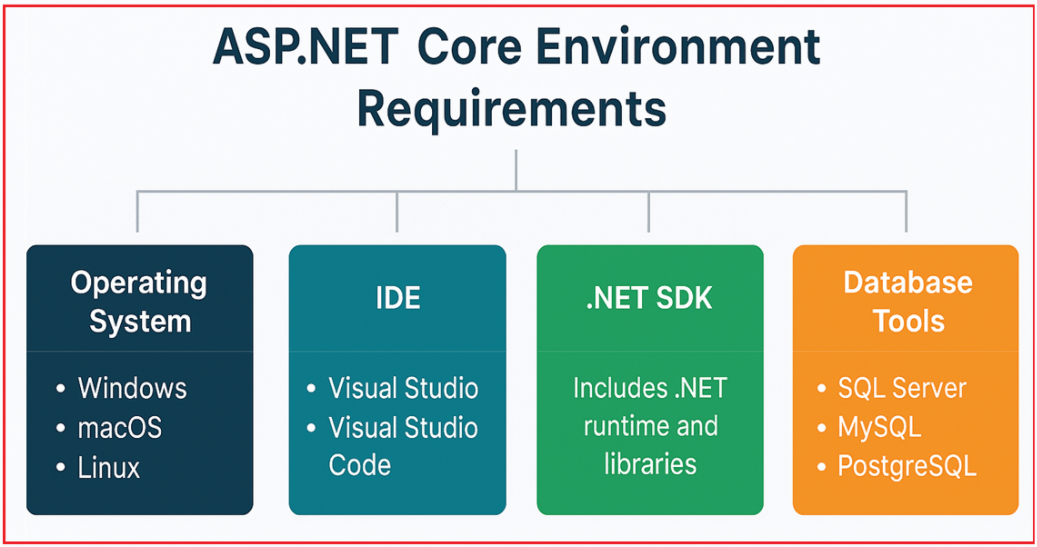Back to: ASP.NET Core Web API Tutorials
ASP.NET Core Environment Setup
Setting up the right development environment is the first step to learning and working with ASP.NET Core. Without the correct tools, SDKs, and database systems, building and running projects can become frustrating and time-consuming.
Now, I will walk you through the essential setup, Operating System, IDE, .NET SDK, Database Tools, and Supporting Utilities, so that you can start coding confidently. Whether you are a beginner or moving towards professional development, following these steps will ensure your environment is stable, efficient, and ready for ASP.NET Core projects.

What is an Operating System (OS)?
An Operating System is the software that manages the hardware and software resources of a computer. It provides a user interface, manages files, runs applications, and controls devices like memory, CPU, and storage.
- Examples: Windows 10/11, macOS, Linux.
- It acts as a bridge between the user and the computer hardware.
- For ASP.NET Core development, the OS serves as the base environment where IDEs, SDKs, and database systems are installed.
OS Choices for ASP.NET Core
ASP.NET Core is a cross-platform framework, meaning you can develop and run applications on Windows, macOS, and Linux.
Windows 10/11
- Best suited for .NET development because Visual Studio (the most powerful IDE for .NET) is fully supported.
- Fully supports Visual Studio (with advanced debugging and tooling).
- Smooth integration with SQL Server and SQL Server Management Studio (SSMS).
- Recommended for beginners and enterprise developers.
macOS
- Supports .NET Core development via Visual Studio Code.
- Some Microsoft-specific tools, such as SQL Server Management Studio (SSMS), are not available; however, alternatives like Azure Data Studio or third-party tools can be used.
Linux
- Ideal for developers who prefer open-source environments.
- Can use Visual Studio Code and the .NET CLI with the .NET SDK installed.
- Popular in cloud and containerized deployments (e.g., Docker + Kubernetes).
- Can connect to SQL Server via Docker, or use MySQL/PostgreSQL/SQLite.
Note: Although ASP.NET Core runs on various platforms, Windows remains the most convenient choice for setup and enterprise connectivity. If you are a beginner, Windows is the most straightforward environment to start with because of Visual Studio’s rich support
Integrated Development Environment (IDE)
An IDE is a software application that provides a complete development environment for programmers. It includes a Code Editor, Debugger, Compiler, Build Automation Tools, and Project Templates. We have the following two IDEs to develop .NET Core Applications.
Visual Studio 2022 (Recommended on Windows)
- Comes with ready-made project templates for ASP.NET Core projects such as ASP.NET Core MVC, ASP.NET Core Web API, ASP.NET Core Blazor, ASP.NET Core Razor Pages, etc.
- Integrated Debugger with breakpoints, watch windows, and step execution.
- Built-in NuGet Package Manager for dependencies.
- Built-in IntelliSense supports innovative code suggestions.
- Provide support for Code Refactoring.
- Easy integration with SQL Server and Entity Framework Core.
- Available in Community (Free), Professional, and Enterprise
Visual Studio Code (Lightweight & Cross-Platform)
- Free, Light-Weight, Open-Source, and Cross-Platform.
- Requires extensions like:
- C# for Visual Studio Code
- Debugger for .NET
- SQL Server for database integration.
- Integrated Git Source Control and Terminal.
- Works across Windows, Linux, and macOS.
- Often preferred by developers who want a lightweight editor or are working outside Windows.
Note: If you’re starting on Windows, use Visual Studio 2022. If you’re working on multiple platforms, use VS Code.
How much Memory is required to install Visual Studio 2022 and Visual Studio Code in Windows OS?
Visual Studio 2022
- Installation Size: 8 GB Minimum (up to 20–50 GB, depending on the selected workloads).
- Minimum RAM: 4 GB (8/16 GB or more for smooth performance when using multiple workloads).
Visual Studio Code
- Installation Size: ~200 MB.
- Minimum RAM: 1 GB (4 GB recommended).
Conclusion: Visual Studio Code is lightweight, while Visual Studio 2022 is feature-rich but heavier.
What is .NET SDK, and why do we need to install .NET SDK?
The .NET SDK (Software Development Kit) provides everything needed to develop, build, and run .NET and ASP.NET Core applications.
It includes:
- .NET Runtime – executes .NET applications.
- Libraries – base class libraries and ASP.NET Core frameworks. Ready-to-use classes for I/O, networking, collections, etc.
- CLI tools – dotnet command-line interface for creating, building, and running projects from the terminal or from command prompts.
Installing .NET SDK gives you everything needed for ASP.NET Core development (including ASP.NET Core libraries). You need the .NET SDK because, without it, you can only run existing .NET apps (via runtime), but cannot develop or build new ones.
Minimum Memory for .NET SDK and Runtime
.NET SDK:
- Installation Size: ~500 MB – 1 GB.
- Minimum RAM: 1 GB (32-bit), 2 GB (64-bit).
.NET Runtime only:
- Installation Size: ~200–300 MB.
- RAM Requirement: 512 MB – 1 GB.
ASP.NET Core
ASP.NET Core is the web framework used for building web applications, RESTful APIs, Microservices, and Real-time apps.
- It is modular, fast, and works across platforms.
- When you install the .NET SDK, ASP.NET Core libraries come bundled with it.
- Provides templates like:
- Web App (MVC)
- Web API
- Blazor App
- Supports modern features: dependency injection, middleware, routing, authentication, etc.
- Installation can be done via:
- Visual Studio Installer (select ASP.NET and web development workload).
- Command Line / Package Manager for macOS/Linux.
Note: Installing the .NET SDK automatically includes ASP.NET Core.
What is a Database Management System (DBMS)?
A Database Management System is software that allows the creation, storage, modification, and management of structured data.
- Examples: SQL Server, MySQL, PostgreSQL, SQLite.
- Provides querying (SQL), transactions, indexing, and security features.
- For ASP.NET Core, a DBMS is essential to store application data like users, orders, logs, etc.
DBMS Options for .NET Development
Most real-world applications require persistent storage. Common choices are:
Microsoft SQL Server (Best for Windows/Enterprise apps)
- Deep integration with ASP.NET Core and Visual Studio.
- Supports advanced features like stored procedures, triggers, and SQL Agent.
- Free edition: SQL Server Express (sufficient for small/medium projects).
MySQL / PostgreSQL
- Popular open-source alternatives.
- Cross-platform, works well with macOS/Linux.
- Supported by Entity Framework Core providers.
SQLite
- Lightweight, file-based DB.
- Perfect for learning, prototyping, and mobile/web apps.
- No server installation required.
Note: Start with SQL Server Express Edition if you’re new, which is free. Migrate to MySQL/PostgreSQL when working across platforms.
What is the Minimum Memory Required to Install Microsoft SQL Server?
- Disk space: ~6 GB minimum (varies by edition).
- RAM (minimum): 2 GB
- Recommended RAM: 4 GB or more for smooth operation.
What is SQL Server Management Tools?
SQL Server Management Tools are the utilities provided by Microsoft (and sometimes third-party vendors) that help developers, database administrators (DBAs), and IT professionals install, configure, manage, and query Microsoft SQL Server databases.
They provide a graphical interface and sometimes command-line utilities to:
- Create and manage databases, tables, views, and stored procedures.
- Write and execute SQL queries.
- Configure security, users, and roles.
- Monitor database performance and troubleshoot issues.
- Perform backups and restores.
Tools Options
SQL Server Management Studio (SSMS)
- Free Microsoft GUI tool for managing SQL Server databases.
- Supports query execution, database design, security management, and backups.
- Windows-only.
Azure Data Studio
- A cross-platform alternative to SSMS.
- Runs on Windows, macOS, and Linux.
- Ideal for those seeking a modern, lightweight SQL management tool.
What is the Minimum Memory Required to Install SSMS?
- Disk space: ~1.5 GB
- RAM (minimum): 2 GB
- Recommended RAM: 4 GB
What is the Minimum Memory Required to Install Azure Data Studio?
- Disk space: ~200 MB
- RAM (minimum): 1 GB
- Recommended RAM: 2 GB
Note: Azure Data Studio is lighter than SSMS and works cross-platform.
What are API Client Tools?
API Client Tools help developers test, debug, and document APIs without needing a frontend application. They allow sending HTTP requests (GET, POST, PUT, DELETE) to your ASP.NET Core Web API and inspecting responses. Needed for:
- Validating endpoints.
- Checking authentication/security.
- Automating API testing.
- Generating documentation.
API Client Tools
Postman
- Widely used API client.
- Send/receive API requests, automate test scripts, and organize API collections.
- Works on Windows/macOS/Linux.
Fiddler
- Web debugging proxy.
- Captures and inspects all HTTP/HTTPS traffic between client and server.
- Useful for debugging API calls, cookies, headers, and performance bottlenecks.
Swagger (OpenAPI)
- API documentation framework.
- Generates interactive API docs automatically from your ASP.NET Core code.
- Provides a web UI to try out API endpoints
Note: Always add Swagger to your ASP.NET Core API projects for better maintainability and client collaboration.
Once your environment is set up, you have everything you need to start building ASP.NET Core applications. As a beginner, focus on using Windows, Visual Studio 2022, .NET SDK, SQL Server Express, and Postman to get started smoothly. As you gain experience, you can expand into advanced tools like Docker, cross-platform development with VS Code, and CI/CD pipelines.
A well-configured environment not only saves time but also gives you confidence while learning and developing. With these foundations in place, you are ready to move forward into real-world ASP.NET Core projects.
Registration Open – Angular Online Training
Session Time: 8:30 PM – 10:00 PM IST
Advance your career with our expert-led, hands-on live training program. Get complete course details, the syllabus, and Zoom credentials for demo sessions via the links below.

